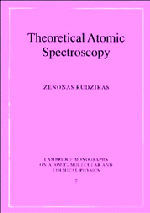Book contents
- Frontmatter
- Contents
- Preface
- Foreword to the Paperback Edition
- Introduction
- Part 1 Energy Spectrum of Many-electron Atom. Radiative and Autoionizing Transitions (Initial Formulas)
- Part 2 Foundations of the Angular Momentum Theory. Graphical Methods
- Part 3 Description of Complex Electronic Configurations
- Part 4 Second-quantization in the Theory of an Atom. Quasispin and Isospin
- Part 5 Matrix Elements of the Energy Operator
- 19 The energy of a shell of equivalent electrons
- 20 Interaction energy of two shells in LS coupling
- 21 Semi-empirical methods of calculation of the energy spectra
- 22 Hyperfine structure of the energy spectra, isotopic and Lamb shift
- 23 Quasispin and isospin for relativistic matrix elements
- Part 6 Electric and Magnetic Multipole Transitions
- Part 7 Calculation of Energy Spectra and Electronic Transitions in the Case of Complex Configurations
- Epilogue
- References
- Index
23 - Quasispin and isospin for relativistic matrix elements
Published online by Cambridge University Press: 21 September 2009
- Frontmatter
- Contents
- Preface
- Foreword to the Paperback Edition
- Introduction
- Part 1 Energy Spectrum of Many-electron Atom. Radiative and Autoionizing Transitions (Initial Formulas)
- Part 2 Foundations of the Angular Momentum Theory. Graphical Methods
- Part 3 Description of Complex Electronic Configurations
- Part 4 Second-quantization in the Theory of an Atom. Quasispin and Isospin
- Part 5 Matrix Elements of the Energy Operator
- 19 The energy of a shell of equivalent electrons
- 20 Interaction energy of two shells in LS coupling
- 21 Semi-empirical methods of calculation of the energy spectra
- 22 Hyperfine structure of the energy spectra, isotopic and Lamb shift
- 23 Quasispin and isospin for relativistic matrix elements
- Part 6 Electric and Magnetic Multipole Transitions
- Part 7 Calculation of Energy Spectra and Electronic Transitions in the Case of Complex Configurations
- Epilogue
- References
- Index
Summary
Relativistic approach and quasispin for one subshell
As we have already seen in Chapters 11 and 12, the realization of one or another coupling scheme in the many-electron atom is determined by the relation between the spin-orbit and non-spherical parts of electrostatic interactions. As the ionization degree of an atom increases, the coupling scheme changes gradually from LS to jj coupling. The latter, for highly ionized atoms, occurs even within the shell of equivalent electrons (see Chapter 31).
With jj coupling, the spin-angular part of the one-electron wave function (2.15) is obtained by vectorial coupling of the orbital and spin-angular momenta of the electron. Then the total angular momenta of individual electrons are added up. In this approach a shell of equivalent electrons is split into two subshells with j = 1 ± 1/2. The shell structure of electronic configurations in jj coupling becomes more complex, but is compensated for by a reduction in the number of electrons in individual subshells.
The energy spectrum of atoms and ions with jj coupling can be found using the relativistic Hamiltonian of N-electron atoms (2.1)–(2.7). Its irreducible tensorial form is presented in Chapter 19. The relativistic one-electron wave functions are four-component spinors (2.15). They are the eigenfunctions of the total angular momentum operator for the electron and are used to determine one-electron and two-electron matrix elements of relativistic interaction operators. These matrix elements, in the representation of occupation numbers, are the parameters that enter into the expansions of the operators corresponding to physical quantities (see general expressions (13.22) and (13.23)).
- Type
- Chapter
- Information
- Theoretical Atomic Spectroscopy , pp. 273 - 290Publisher: Cambridge University PressPrint publication year: 1997
- 1
- Cited by



